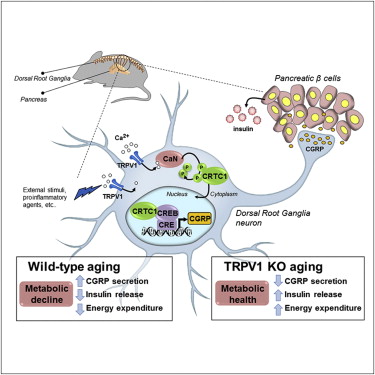Blocking Pain Receptors May Lead To A Longer Life
This article is more than 2 years old
 As scientists continue to make breakthroughs in radical life extension, Google’s lofty goal of solving death and transhumanists’ pursuit of immortality seem less and less farfetched. The latest of these discoveries is that mice genetically designed to lack a pain receptor called TRPV1 are less prone to age-related diseases and live much longer.
As scientists continue to make breakthroughs in radical life extension, Google’s lofty goal of solving death and transhumanists’ pursuit of immortality seem less and less farfetched. The latest of these discoveries is that mice genetically designed to lack a pain receptor called TRPV1 are less prone to age-related diseases and live much longer.
Pain receptors serve an important purpose, they indicate when we might be in danger. If they didn’t, we might jump into fires or step into the ring against someone twice our size. But for all the important warning messages pain receptors send, pain harms us, and not just in the obvious way. Studies have shown that people who suffer chronic pain are likely to live shorter lives, though no one knows exactly why.
In an attempt to investigate the relationship between pain and lifespan, University of California Berkeley researchers bred mice without TRPV1 receptors, which are located in joints, nerves, and the skin. TRPV1 is activated by capsaicin, an active component of chili peppers. While capsaicin burns our mouths (and skin and eyes if we’re so unfortunate), it also has some purported health benefits, including high levels of antioxidants, and is used in some topical pain medication. In their study published in Cell magazine, the researchers found that mice lacking these receptors lived approximately 14% longer than those who had them. The TRPV1-less mice still aged, but their metabolisms remained “youthful,” they continued to burn more calories than older mice, and their glucose tolerance remained higher than their counterparts.
Researchers believe there’s a relationship between TRPV1 and insulin regulation. Insulin removes sugar from the blood, which becomes more difficult with age. These receptors cause the release of CGRP in the pancreas, which blocks insulin from the bloodstream, making it more difficult to regulate or clear sugar from the blood. The mice without TRPV1 produced less CGRP and had higher insulin levels. Researchers note the consistency between this finding and the extraordinarily long lifespan (30+ years) of the naked mole rat, which doesn’t produce CGRP.
 Pharmaceutical companies are developing TRPV1 and CGRP-based processes for treating pain, diabetes, and obesity, but researchers think they may be capable of delivering other long-lasting health benefits. One of the potential advantage of capsaicin is that it reduces appetite (probably because people can’t feel their tongues after tasting it), and calorie restriction has been shown as one of the most effective ways to lengthen the lifespans of mice and monkeys.
Pharmaceutical companies are developing TRPV1 and CGRP-based processes for treating pain, diabetes, and obesity, but researchers think they may be capable of delivering other long-lasting health benefits. One of the potential advantage of capsaicin is that it reduces appetite (probably because people can’t feel their tongues after tasting it), and calorie restriction has been shown as one of the most effective ways to lengthen the lifespans of mice and monkeys.
People would have to eat a whole ton of hot peppers to extend their lives via capsaicin consumption, but research shows that prolonged capsaicin exposure can eradicate the neuron that delivers TRPV1’s signals, which may have the same result as being bred without TRPV1. If there’s a choice between daily hot pepper baths or the constant inhaling of male musk in order to reduce pain and thus live a longer life, I’ll take the former.












